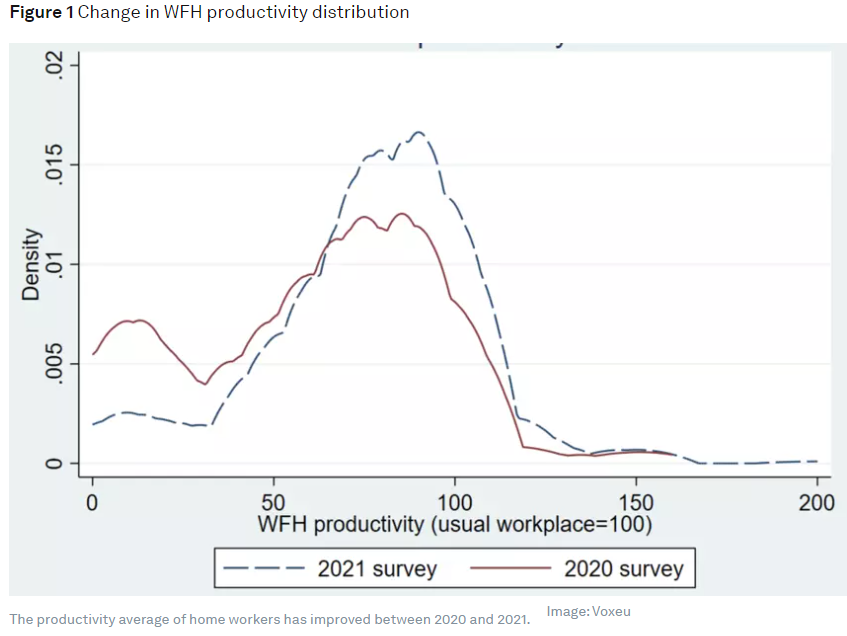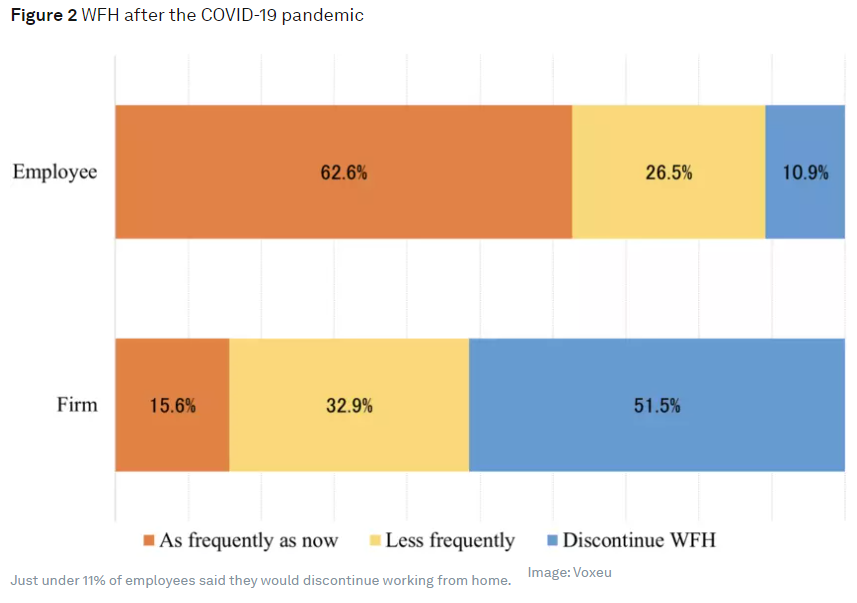by Masayuki Morikawa*
Since the onset of the COVID-19 pandemic, the number of workers working from home (WFH) has been increasing rapidly. There has also been a rapid, parallel increase in research on WFH. We now know what workers need to be able to WFH as well as what type of workers are actually WFH. Findings generally show that highly skilled, high-wage, white-collar employees in large firms tend to WFH, meaning that the expansion of WFH has tended to increase inequality in the labour market. However, productivity of WFH has not yet been well understood.
Studies on WFH productivity during the COVID-19 pandemic
Currently, business managers and policy practitioners are interested in whether WFH will continue as a new workstyle after the COVID-19 pandemic ends. Productivity of WFH is a key determinant of whether WFH will persist or not, but quantitative evidence on WFH productivity is still limited. Studies based on surveys of workers include Etheridge et al. (2020), Barrero et al. (2021), and my work (Morikawa 2020).1 Since it is extremely challenging to measure the productivity of white-collar workers, who perform a large variety of tasks, all of these studies depend on the workers’ self-assessment of WFH productivity.
Etheridge et al. (2020) show that, on average, workers in the UK adopting WFH report little difference in productivity relative to productivity before the pandemic. In the US, Barrero et al. (2021) indicate that most respondents who adopted WFH report equal to or higher WFH productivity than productivity on business premises. My study (Morikawa 2020) was based on a 2020 survey of workers in Japan and documents that the mean WFH productivity was approximately 60% to 70% relative to working at the usual workplace and that it was lower for employees who were forced to start WFH only after the spread of the COVID-19 pandemic. To summarise, studies on the productivity of WFH under the COVID-19 pandemic are still limited, and the results are far from conclusive.
To explore the productivity dynamics of WFH during the COVID-19 pandemic, I extend the analysis of my 2020 study. I conducted a follow-up survey in 2021 to explore the changes in prevalence, frequency, and productivity of WFH during a year of the pandemic and discuss the future of WFH after the COVID-19 pandemic (Morikawa 2021).
Prevalence and frequency of WFH
Our 2021 survey asked workers in Japan about the adoption and frequency of WFH. The responses show that 21.5% of workers were practising WFH, which is a decrease from 32.2% a year prior. Among only continuing (panel) respondents, the extent of the decline was larger: it decreased from 37.1% to 21.1%. Of the employees who responded to both 2020 and 2021 surveys, 41.7% stopped practising WFH, indicating that a non-negligible number of workers reverted to working at their usual workplace. In particular, individuals with lower WFH productivity had a higher probability of exiting from WFH.
In contrast, the mean share of WFH days (WFH days divided by weekly working days) is almost unchanged during the past year: 55.7% in the 2020 survey and 56.6% in the 2021 survey. Even for the subsample of those who responded to both surveys and who continued to implement WFH, the mean frequencies of WFH are almost unchanged (55.9% in 2020 and 54.3% in 2021). While the change in the extensive margin (adoption) is relatively large, the change in the intensive margin (frequency) is negligible.
Productivity dynamics of WFH
The surveys asked the subjects to self-assess WFH productivity relative to one’s productivity at the usual workplace (= 100). The distributions of WFH productivity in 2020 and 2021 are in Figure 1. The figure shows that (1) the overall distribution has shifted slightly right, and (2) the lower end of the distribution has shrunk substantially. The mean WFH productivity has improved from 61 in 2020 to 78 in 2021 (where productivity at the usual workplace = 100). The subsample of panel employees shows a similar pattern: the mean productivity has improved from 61 to 77.

The WFH productivity of those who continuously engaged in WFH improved from 70 in 2020 to 78 in 2021. The 8-point increase in WFH productivity comes from, for example, learning effects and investment in WFH infrastructure at home. The mean WFH productivity in the 2020 survey of those who exit from WFH was 49, far lower than that of WFH continuers (70). This selection mechanism contributes to a 9-point improvement in mean WFH productivity. In short, (1) a ‘selection effect’ arising from the exit of low-WFH-productivity employees from WFH practice, and (2) the improvement in WFH productivity through a ‘learning effect’ contributed almost equally to the improved mean WFH productivity.
WFH after the COVID-19 pandemic
Both the 2020 and 2021 surveys asked the telecommuters about their intention to continue WFH after the pandemic. The percentage of WFH workers who answered they would like to practice WFH at the same frequency as they currently do even when the COVID-19 pandemic subsides increased substantially from 38.1% in the 2020 survey to 62.6% in the 2021 survey (Figure 2). Even for the subsample of WFH continuers, the percentage has increased from 56.2% to 68.2%.

We posit that the possible reasons behind this change are (1) the improvement in WFH productivity, and (2) the increasing recognition of the amenity value of WFH. Since there was a strong positive correlation between the intention in 2020 to continue frequent WFH and the actual implementation of WFH in 2021, the result suggests that WFH may become a preferred work style even after the pandemic subsides. As described before, the productivity of WFH is, on average, still lower than that of the usual workplace, meaning that WFH has a high amenity value for teleworkers.
However, according to a survey of Japanese firms conducted in late 2021, the majority of firms are planning to discontinue the WFH practice and revert to the conventional workstyle after the end of COVID-19 (Morikawa 2022b). These contrasting results indicate that there is a large gap between firms’ interests and the preferences of WFH workers. From the viewpoints of the productivity-wage parity and the compensating wage differential, it is possible that WFH workers’ relative wages will be reduced. However, since it is difficult to accurately capture the productivity of individual workers who perform WFH, there is a potential that conflict between workers and management over WFH will arise after the pandemic.
*Vice President, Research Institute of Economy, Trade and Industry (RIETI)
**first published in: www.weforum.org




 By: N. Peter Kramer
By: N. Peter Kramer
